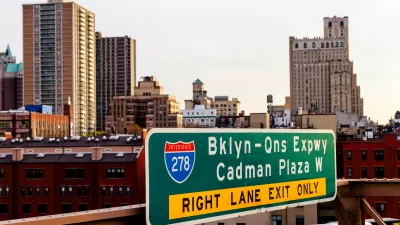The New York City roadway is desperately in need of repair, but just tearing it down and replacing it would be a shortsighted fix.

Justin Davidson ponders the future of the Brooklyn-Queens Expressway, which he would like to see come down for good rather than just replaced with the same:
So far, the city’s DOT has floated two, more or less equally horrendous options: make piecemeal repairs, causing eight years of Munch’s Scream-level congestion, or commandeer the Brooklyn Heights Promenade as a temporary highway and tolerate a different kind of misery for a mere six years.
Concerns about traffic congestion and what would happen to freight vehicles using the BQE if it went away completely should not be used to defend a replacement project that, conservatively, would cost $3 billion to $4 billion, says Davidson. Instead, he argues for a long-term vision that considers where transportation is headed—in terms of technology and travel modes—and goals like sustainability.
Davidson also spends time considering the stacked design of the BQE and the park and public space of the Brooklyn Heights Promenade. Burying the roadway, he suggests, would be a good alternative for reclaiming this space, even if a tunnel would be costly and time consuming. "To anyone who ever sat for hours, fumigated and immobilized, on the I-93 [in Boston] at rush hour, being able to stroll along the Rose Kennedy Greenway, which follows the same route, is a major urban gift."
FULL STORY: Here’s a Solution for Fixing the Brooklyn-Queens Expressway: Get Rid of It

Maui's Vacation Rental Debate Turns Ugly
Verbal attacks, misinformation campaigns and fistfights plague a high-stakes debate to convert thousands of vacation rentals into long-term housing.

Planetizen Federal Action Tracker
A weekly monitor of how Trump’s orders and actions are impacting planners and planning in America.

In Urban Planning, AI Prompting Could be the New Design Thinking
Creativity has long been key to great urban design. What if we see AI as our new creative partner?

King County Supportive Housing Program Offers Hope for Unhoused Residents
The county is taking a ‘Housing First’ approach that prioritizes getting people into housing, then offering wraparound supportive services.

Researchers Use AI to Get Clearer Picture of US Housing
Analysts are using artificial intelligence to supercharge their research by allowing them to comb through data faster. Though these AI tools can be error prone, they save time and housing researchers are optimistic about the future.

Making Shared Micromobility More Inclusive
Cities and shared mobility system operators can do more to include people with disabilities in planning and operations, per a new report.
Urban Design for Planners 1: Software Tools
This six-course series explores essential urban design concepts using open source software and equips planners with the tools they need to participate fully in the urban design process.
Planning for Universal Design
Learn the tools for implementing Universal Design in planning regulations.
planning NEXT
Appalachian Highlands Housing Partners
Gallatin County Department of Planning & Community Development
Mpact (founded as Rail~Volution)
City of Camden Redevelopment Agency
City of Astoria
City of Portland
City of Laramie




























